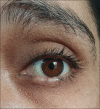Atypical Presentation of Halo Nevus over Eyelid with Poliosis: A Dermatoscopic Perspective
- PMID: 35531486
- PMCID: PMC9069907
- DOI: 10.4103/ijt.ijt_150_20
Atypical Presentation of Halo Nevus over Eyelid with Poliosis: A Dermatoscopic Perspective
Abstract
Halo nevus (HN) is benign skin condition with a central melanocytic nevus, surrounded by an area or halo of depigmentation. It is the result of immunological response of the body toward the nevus, which destroys the melanocytes in surrounding skin, leading to the depigmented halo. An increased frequency of HN in patients with vitiligo is observed. It is more commonly seen in children or young adults of either sex, particularly on the trunk, less commonly on the face, neck, and limbs. We present a rare case of HN which was present on the lower eyelid associated with poliosis, diagnosed with dermatoscopy.
Keywords: Dermatoscopy; halo nevus; melanocytic nevus; poliosis.
Copyright: © 2022 International Journal of Trichology.
Conflict of interest statement
There are no conflicts of interest.
Figures



Similar articles
-
Poliosis of eyelashes as an unusual sign of a halo nevus.Korean J Ophthalmol. 2010 Aug;24(4):237-9. doi: 10.3341/kjo.2010.24.4.237. Epub 2010 Aug 3. Korean J Ophthalmol. 2010. PMID: 20714388 Free PMC article.
-
Meyerson Phenomenon as a Component of Melanoma in situ.Acta Dermatovenerol Croat. 2016 Apr;24(1):81-2. Acta Dermatovenerol Croat. 2016. PMID: 27149137
-
Development of Halo Nevus Around Nevus Spilus as a Central Nevus, and the Concurrent Vitiligo.Ann Dermatol. 2008 Dec;20(4):237-9. doi: 10.5021/ad.2008.20.4.237. Epub 2008 Dec 31. Ann Dermatol. 2008. PMID: 27303201 Free PMC article.
-
Morphological features of melanocytic tumors with depigmented halo: review of the literature and personal results.Rom J Morphol Embryol. 2015;56(2 Suppl):659-63. Rom J Morphol Embryol. 2015. PMID: 26429156 Review.
-
Role of In Vivo Reflectance Confocal Microscopy in the Analysis of Melanocytic Lesions.Acta Dermatovenerol Croat. 2018 Apr;26(1):64-67. Acta Dermatovenerol Croat. 2018. PMID: 29782304 Review.
Cited by
-
Sequential Dermoscopy and Reflectance Confocal Microscopy Paired With Pigmented Lesion Assay Gene Expression Profiling for In Vivo Monitoring of Multiple Halo Nevi on an Adult Patient.Cureus. 2023 Nov 26;15(11):e49465. doi: 10.7759/cureus.49465. eCollection 2023 Nov. Cureus. 2023. PMID: 38152824 Free PMC article.
References
-
- Ortonne JP, Passeron T. Vitiligo and other disorders of hypopigmentation. In: Bolognia JL, Jorizzo JL, Schaffer JV, editors. Textbook of Dermatology. 3rd. China: Elsevier Saunders; 2012. pp. 1023–48.
-
- Bishop JA. Lentigos, melanocytic nevi and melanomaRook's Textbook of Dermatology. In: Burns T, Beathnach S, Cox N, Griffiths C, editors. Lentigos, melanocytic nevi and melanoma. United Kingdom: Wiley Blackwell; 2010. pp. 54.19–20.
-
- Ezzedine K, Diallo A, Léauté-Labrèze C, Seneschal J, Mossalayi D, AlGhamdi K, et al. Halo nevi association in nonsegmental vitiligo affects age at onset and depigmentation pattern. Arch Dermatol. 2012;148:497–502. - PubMed
-
- Patrizi A, Neri I, Sabattini E, Rizzoli L, Misciali C. Unusual inflammatory and hyperkeratotic halo naevus in children. Br J Dermatol. 2005;152:357–60. - PubMed
-
- Hafi NA, Bachaspatimayum R, Soraisham R, Muhammed NC. Halo nevi in children: A separate entity or a sign of vitiligo? Indian J Paediatr Dermatol. 2019;20:227–30.
Publication types
LinkOut - more resources
Full Text Sources
